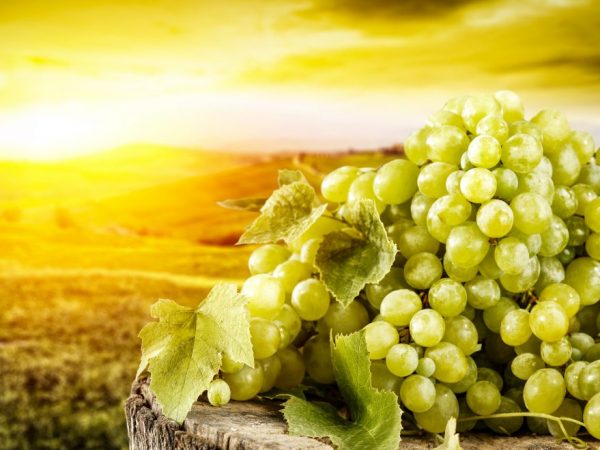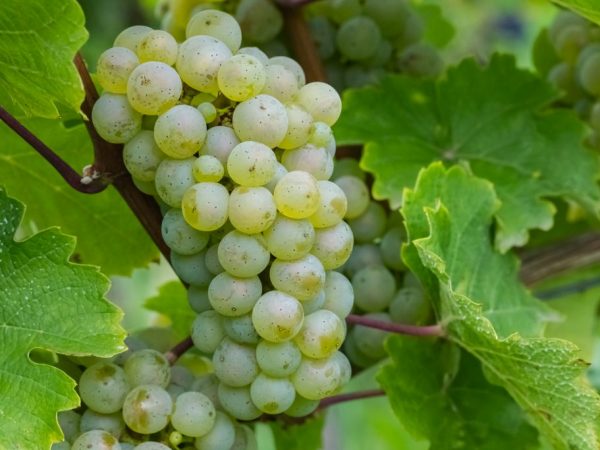Useful properties of green grapes
Green grapes are very sweet and rich in vitamins and minerals. The berries are suitable for processing and are eaten fresh. Today there are 800 different grape varieties in the world.

Useful properties of green grapes
Benefit and harm
The health benefits of green grapes are undeniable. It contains useful vitamins and minerals that actively boost immunity. Antioxidants have a rejuvenating effect. Used for the production of anti-aging creams, nourishing masks and scrubs for the face and body.
BZHU - 0.6x0.6x15.4.
Vitamins in green grapes:
- phosphorus;
- potassium;
- ascorbic acid (antioxidant);
- calcium;
- B vitamins;
- magnesium;
- iron;
- manganese.
Vitamins in green grapes are preserved even after heat treatment and drying. Carbohydrates and fiber help speed up metabolism.
Red grapes are healthier, but green grapes are less allergenic, so they are allowed for pregnant and lactating women. The processed juice will help a young mother to quickly restore strength and enrich the body with vitamins necessary to maintain beauty and health.
Green grapes are useful with catechins, which can be found in large quantities in individual varieties. They protect against breast, bladder and prostate cancer.
The benefits of pitted green grapes are that they contain the oils necessary for the proper functioning of the capillaries. Antioxidants, in combination with natural oils, promote the resorption of blood clots and the elimination of toxins, cholesterol from the body in a natural way.
The harm of green grapes is their high carbohydrate content. The berry is contraindicated for diabetics, gastritis, patients after surgery.
Existing varieties
The most common varieties of green grapes for table use: Kishmish round and oval, White miracle, Bazhena, Valentina, Ladies fingers.
Technical types: White Muscat, Chardonnay, Albarinier, Aligote, Riesling.
Varieties of universal use (they combine the properties of canteens and technical ones): Arora, Albillo.
Varieties of green grapes are thermophilic plants. Over the years of breeding and practice, it was possible to regionalize several varieties that are moderately frost-resistant, which survive in severe frosts. The best varieties, zoned in Russia: White miracle, Chardonnay, White Muscat, Bazhena, Valentina.
White miracle
Table hybrid, low to medium stature. The bunch can weigh up to 900 g. The berries are large, light green.
The main bonus is the good quality of the fruit and ease of care. They keep their presentation for a long time. The yield is stable, average. Among the shortcomings, gardeners highlight the fragility of one-year-old shoots. One of the few varieties allowed for use with hepatitis B and pregnancy in small quantities.
Chardonnay
The variety is suitable for making white wines. Low-yielding, early species. Ripening period - 140 days.
The bunches are cylindrical. The fruit is round, green with seeds. The pulp has a strong, pleasant aroma, sweet. The skin is thin, dense structure, which allows the fruit to be stored for a long time. Green Chardonnay grapes, whose properties have long been appreciated by growers, has several disadvantages:
- high susceptibility to disease;
- low resistance to spring frosts;
- tendency to pea.
White nutmeg

The variety has an excellent taste.
Green grapes, the beneficial properties of which have been known since antiquity. Used in technical viticulture. An early variety of medium height. Zoned in the southern latitudes of Russia, does not tolerate frosts.
The bunch is cylindrical, medium density. The berries are light green. The pulp has a delicate structure with excellent taste. The description indicates a high susceptibility of plants to fungal diseases and pests progressing in a humid climate.
Bazhena
Self-pollinated tall bush. The ripening period is only 100 days. Bunches of conical and cylindrical shape. The density is average. Refers to table hybrids.
Upon reaching technical maturity, the berries are green with a yellowish tinge. The pulp is nutritious, juicy. The taste combines notes of apple and cherry. The berries are easy to transport.
Valentine
Table vigorous, high-yielding, disease-resistant species. Demanding on the composition of the soil and care. The bunch consists of green oblong berries with 2 seeds. The length of the bunch reaches 40 cm.
The fruit is large. The pulp is tender, melts in the mouth, sweet with a sage aftertaste. The juice is used to make sweet white wine. The skin is thin, easily damaged. Excess moisture leads to cracking of the fruit.
Landing features
Reproduction of green grapes is carried out by layering. In the spring, they need to be rooted without tearing them off the bush. When the cutting takes root, it is carefully detached from the bush. Cuttings of frost-resistant varieties bought on the market are planted in spring, low-resistance to cold in summer. Before planting, the root system of the shoots is placed in a manganese solution for 12 hours.
The plants sprouted from the seeds do not inherit the properties of the parent bushes. Retain individual features. When propagated by cuttings, powerful lignified shoots are cut in the fall and planted in plastic cups for the winter. In the spring, they are transplanted to an open area.
Green varieties prefer nutritious fertile chernozem soils. They take root poorly on loams. The pits are prepared in the fall. Potassium, phosphorus and nitrogen are added. The size of the pit is 80x80x80 - for chernozem areas, 100x100x100 - for sandy loam. A layer of crushed stone or expanded clay is placed at the bottom of the pit to provide the roots with air and protect them from waterlogging; lay a layer of soil with mineral fertilizers on it.
Before planting, treat the root system with a roaster consisting of humate, clay and water at room temperature. In the pit, make a mound on which to distribute the root system and cover with fertile soil mixed with sand and superphosphate. Equip a drip irrigation system.
Care
Care measures:
- in the summer - wreckage, garter, watering, preventive treatment, top dressing;
- in the fall - preventive treatment for pest diseases, preparation for winter;
- in spring - sanitary pruning, garter, pest treatment with copper sulfate or Bordeaux liquid.
Caring for green grapes in the warm season consists in shortening shoots, pinching. Pruning is carried out on specimens above 170 cm. Top dressing is started from the 4th year of life on the site. Remove excess stepchildren completely in order to redirect the forces of the plant to the formation of powerful shoots and berries. At the beginning of the season, treatment with Rudomil, diluted with Fufanon, is carried out.
In the fall, preparatory work is carried out in the vineyard. After harvesting, feed the plants with organic matter mixed with ash.Autumn pruning is carried out after the foliage has fallen. Prepare varieties that are resistant to frost for winter. Make a mound around the trunk, cut the vine to bend it to the ground and cover it with spruce branches.
The first watering is carried out after removing the winter shelter. Young seedlings are watered through pipes dug into the ground. For 1 bush 4 buckets of water.
The second watering is 7 days before flowering, the third - at the end of flowering. A week before the shelter, the last water-charging irrigation is carried out.
Nitrogen-containing fertilizers are applied before flowering. Its application at a later date will lead to an increase in the deciduous part and reduce yields. Alternate root dressing with foliar. For foliar dressing, use ready-made complex preparations: Novofert, Plantafol, Kemira. The garter is carried out in the spring after removing the shelter and in the summer when new shoots appear.
Final part
Green grapes are healthier than other varieties. They are lower in calories and are allowed in the diet. Green grapes have something that other varieties lack - a unique combination of flavonoids and antioxidants. Plants are not resistant to cold weather, they require mandatory shelter for the winter. Subject to agrotechnical rules, there will be no problems with grapes of green varieties.


